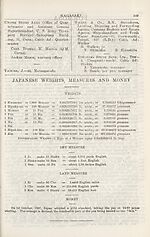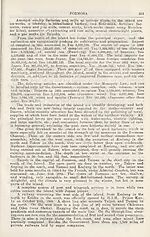1933
(408) [Page 350] - Formosa
Download files
Complete book:
Individual page:
Thumbnail gallery: Grid view | List view
![(408) [Page 350] - Formosa](https://deriv.nls.uk/dcn17/2036/7961/203679617.17.jpg)
FORMOSA
This island, one of the largest in Asia, is situated between latitude 22 and
26 degrees N., and longitude 120 and 122 degrees E., and is separated from
the coast of Fukien, China, by a channel about one hundred miles in width.
It is a prolongation of the Japanese and Loochoo Archipelagoes, and in ISOi*
was incorporated in the Japanese Empire. Its name Formosa, signifying
“beautiful island,” was conferred by the , Portuguese, the first Europeans to
visit it, but it was called Taiwan ('Great Bay) by the Chinese, to whom it
belonged from 1661 to 1694. It is said that the Japanese endeavoured to-
form a colony in the island in 1626, but large numbers of Chinese were settled
there prior to that date. The (Dutch arrived in 1634, and founded several
settlements, and traces of their occupation are still to be found in the island,
but they were compelled in 1661 to retire by the Chinese pirate chief Koxinga,
who then assumed the sovereignty of western Formosa. His grandson and
.successor, however, was induced, twenty-two years later, to resign the crown
to the Emperor of China. By the Treaty of Shimonoseki, which terminated
the war betv/ee'n China and Japan m 1893, the island was ceded
to Japan as one of the conditions of peace, and on the 1st June, 1895r
the formal surrender was made, the ceremony taking place on board ship
outside iKeelung. The resident Chinese officials, however, declared a republic,
and offered resistance, and it was not until the end of October that the oppos¬
ing forces were completely overcome, the last stand being made in the south,
by Liu Yung-fu, the Black Flag 'General, of Tonkin notoriety. Takowr wav
bombarded and captured on 15th October, and Anping was peacefully occupied
on the 21st of the same month, Liu Yung-fu having taken refuge in flight.
Formosa is about 260 miles in length, and from 60 to 70 miles broad in
the widest part. It is intersected from north to south by a range of mountains,
which forms a kind of backbone to the island, the loftiest peak of which.
Mount Morrison (Niitakayama), is 13,880 feet high. On the western side of
this range the slope is more gradual than on the eastern side, and broken
by fertile valleys which lose themselves in the large undulating plain on which
the Chinese are settled. The high land east of the dividing chain is peopled
by an aboriginal race who acknowledge no allegiance to the Chinese Govern¬
ment and made frequent raids upon the outlying Chinese settlements, but
as the island is being steadily opened up conditions are improving, and
doubtless in course of time they will become merged in the general popula¬
tion, although naturally a savage and warlike people, allied to the Malays
and iPolyneisians, who lived principally by the chase.
The population of Formosa in 1928 was estimated to be 4,241,759, an in¬
crease of 22 per cent, over that of 1918. In October 19?0 the population was
estimated as being Japanese 220,370, Formosan (including Aborigines) 4,198,-
783, Foreign (mainly Chinese) 43,118.
The products of Formosa are numerous, vegetation being everywhere most
luxuriant, testifving to the richness of the soil. Tea, camphor, rice, sugar
and bananas are largely cultivated, the three latter being extensively shipped
to Japan. The fauna includes bears, monkeys, deer, wild boar, badgers,,
martens, the scaly ant-eater and other smaller animals. Birds are not very
numerous, and snakes not as common as might; bee expected where vegetation
is so abundant. As regards minerals there are at present only two gold mines-
running {viz., those at Kinkasaki and Zuiho in the vicinity of Keelung), and
the production of both Gold and iSilver in Taiwan has decreased, as they are
being shipped to Japan in the form of Ores. The foreign trade, including
that with Javan amounted to Y. 409,700,389 in 1930. The big items of
export are sugar, Oblong tea, bananas, rice, eoal and camphor. In trade
with foreign countries the imports on the average exceed the exports. The
island has an area of about 5,690 square miles of which more than half is
mountain, never the less 21.5 per cent is cultivated land and over 58 per
^ent. of the population are farmers.
This island, one of the largest in Asia, is situated between latitude 22 and
26 degrees N., and longitude 120 and 122 degrees E., and is separated from
the coast of Fukien, China, by a channel about one hundred miles in width.
It is a prolongation of the Japanese and Loochoo Archipelagoes, and in ISOi*
was incorporated in the Japanese Empire. Its name Formosa, signifying
“beautiful island,” was conferred by the , Portuguese, the first Europeans to
visit it, but it was called Taiwan ('Great Bay) by the Chinese, to whom it
belonged from 1661 to 1694. It is said that the Japanese endeavoured to-
form a colony in the island in 1626, but large numbers of Chinese were settled
there prior to that date. The (Dutch arrived in 1634, and founded several
settlements, and traces of their occupation are still to be found in the island,
but they were compelled in 1661 to retire by the Chinese pirate chief Koxinga,
who then assumed the sovereignty of western Formosa. His grandson and
.successor, however, was induced, twenty-two years later, to resign the crown
to the Emperor of China. By the Treaty of Shimonoseki, which terminated
the war betv/ee'n China and Japan m 1893, the island was ceded
to Japan as one of the conditions of peace, and on the 1st June, 1895r
the formal surrender was made, the ceremony taking place on board ship
outside iKeelung. The resident Chinese officials, however, declared a republic,
and offered resistance, and it was not until the end of October that the oppos¬
ing forces were completely overcome, the last stand being made in the south,
by Liu Yung-fu, the Black Flag 'General, of Tonkin notoriety. Takowr wav
bombarded and captured on 15th October, and Anping was peacefully occupied
on the 21st of the same month, Liu Yung-fu having taken refuge in flight.
Formosa is about 260 miles in length, and from 60 to 70 miles broad in
the widest part. It is intersected from north to south by a range of mountains,
which forms a kind of backbone to the island, the loftiest peak of which.
Mount Morrison (Niitakayama), is 13,880 feet high. On the western side of
this range the slope is more gradual than on the eastern side, and broken
by fertile valleys which lose themselves in the large undulating plain on which
the Chinese are settled. The high land east of the dividing chain is peopled
by an aboriginal race who acknowledge no allegiance to the Chinese Govern¬
ment and made frequent raids upon the outlying Chinese settlements, but
as the island is being steadily opened up conditions are improving, and
doubtless in course of time they will become merged in the general popula¬
tion, although naturally a savage and warlike people, allied to the Malays
and iPolyneisians, who lived principally by the chase.
The population of Formosa in 1928 was estimated to be 4,241,759, an in¬
crease of 22 per cent, over that of 1918. In October 19?0 the population was
estimated as being Japanese 220,370, Formosan (including Aborigines) 4,198,-
783, Foreign (mainly Chinese) 43,118.
The products of Formosa are numerous, vegetation being everywhere most
luxuriant, testifving to the richness of the soil. Tea, camphor, rice, sugar
and bananas are largely cultivated, the three latter being extensively shipped
to Japan. The fauna includes bears, monkeys, deer, wild boar, badgers,,
martens, the scaly ant-eater and other smaller animals. Birds are not very
numerous, and snakes not as common as might; bee expected where vegetation
is so abundant. As regards minerals there are at present only two gold mines-
running {viz., those at Kinkasaki and Zuiho in the vicinity of Keelung), and
the production of both Gold and iSilver in Taiwan has decreased, as they are
being shipped to Japan in the form of Ores. The foreign trade, including
that with Javan amounted to Y. 409,700,389 in 1930. The big items of
export are sugar, Oblong tea, bananas, rice, eoal and camphor. In trade
with foreign countries the imports on the average exceed the exports. The
island has an area of about 5,690 square miles of which more than half is
mountain, never the less 21.5 per cent is cultivated land and over 58 per
^ent. of the population are farmers.
Set display mode to:
![]() Universal Viewer |
Universal Viewer | ![]() Mirador |
Large image | Transcription
Mirador |
Large image | Transcription
Images and transcriptions on this page, including medium image downloads, may be used under the Creative Commons Attribution 4.0 International Licence unless otherwise stated. ![]()
| Asian directories and chronicles > 1933 > (408) [Page 350] - Formosa |
|---|
| Permanent URL | https://digital.nls.uk/203679615 |
|---|
| Attribution and copyright: |
|
|---|---|
| Description | Volumes from the Asian 'Directory and Chronicle' series covering 1917-1941, but missing 1919 and 1923. Compiled annually from a multiplicity of local sources and research. They provide listings of each country's active corporations, foreign residents and government agencies of all nationalities for that year, together with their addresses. Content includes: various treaties; coverage of conflicts; currencies and taxes; consular fees; weights and measures; public holidays; festivals and traditions. A source of information for both Western states and communities of foreigners living in Asia. Published by Hongkong Daily Press. |
|---|---|
| Shelfmark | H3.86.1303 |
| Additional NLS resources: |

